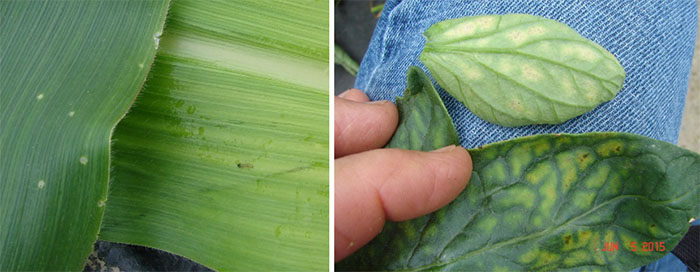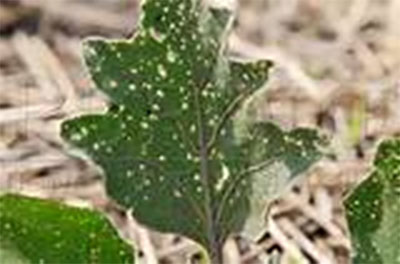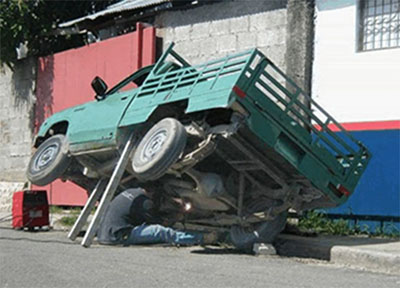"We are what we repeatedly do. Excellence, then, is not an act, but a habit." --Aristotle
Address any questions or comments regarding this newsletter to the individual authors listed after each article or to its editor, Rick Weinzierl, 217-333-6651, weinzier@illinois.edu. To receive e-mail notification of new postings of this newsletter, call or write the same number or address.
In This Issue:
Upcoming Programs (listings for beginning and established growers)
Regional Reports (from southern and western Illinois)
Fruit Production and Pest Management (quick notes on rainfastness, PHIs, and spotted wing Drosophila, and stink bugs)
Vegetable Production and Pest Management (corn earworm and European corn borer, flea beetles)
Local Foods Issues (2015 Illinois Farmers Market Price Reporting)
Upcoming Programs
Check the Illinois SARE calendar for a full list of programs and links for registration.
http://illinoissare.org/ and http://illinoissare.org/calendar.php
Also see the University of Illinois Extension Local Food Systems and Small Farms Team's web site at:
http://web.extension.illinois.edu/smallfarm/ and their calendar of events at http://web.extension.illinois.edu/units/calendar.cfm?UnitID=629.
- Southern Illinois Summer Twilight Series Meeting, June 15, 2015. 6:00 p.m. at Ridge Road Vineyard, 1653 Ridge Road, Pulaski, IL 62976. Program is free but pre-registration is required by Friday, May 15, at https://web.extension.illinois.edu/registration/?RegistrationID=12224 or by phone at 618-382-2662. For more information, check the link provided or contact: Bronwyn Aly at baly@illinois.edu or 618-382-2662 or Nathan Johanning at njohann@illinois.edu or 618-687-1727.
Regional Reports
From southern Illinois ... Rain has been plentiful (and more) in southern Illinois. Within the last eight days here in Murphysboro we have received almost 3.5 inches spread among three main rainfall events, including the last 1.5 inches on Monday morning. From that system, I have gotten reports of rainfall totals of up to 3 inches. Temperatures were very cool especially on Sunday, May 30, and we had a stretch of about 4 days of consistently cloudy weather around that time. Since then, we have had more summer like temperatures with highs in the 80s and low 90s with plenty of humidity.
The rain has made it a challenge to keep fungicide sprays on apples, peaches, and grapes, along with vegetables. However, the rain and humidity also have made for ideal conditions for disease development, making these sprays crucial. This year again has been ideal for fire blight in apples and pears, and it has really shown up over the last couple of weeks.
We have arrived at my favorite time of year for fruit crops, which is the first taste of some of our summer crops. At home on the farm we had a nice tart cherry crop which peaked about 10 days ago. This past weekend I found myself "grazing" my way through some black raspberries, just a few early red raspberries, gooseberries, and blueberries. 'Duke', 'Earliblue', and 'Bluegold' were the first blueberry varieties I harvested in my planting. Thus far, I have not heard any reports of spotted wing drosophila (SWD) in small fruits, but in recent years infestations have started a little later in June or early July so be prepared on any small fruit plantings to protect for and monitor for this insect. Refer back to IFVN issue 20:17 from March 19th for more details on SWD management. My small planting of red raspberries are 'Nantahala' (primocane fruiting) and due to many issues with SWD in the late harvests last year I decided to leave some of the florocanes to fruit this year in hopes that I can avoid harvesting during the peak populations of SWD. Research has shown you typically get a lower yield taking the spring harvest, but given the nature of SWD, I thought I would give this a try on a small scale.
Remember that with all of the rain we are getting, new weed flushes keep occurring, so keep up with cultivations or mulching or investigate preemergence herbicide options in the Midwest Vegetable Production Guide. Although we have very few "silver bullets" for vegetable weed control, the preemergence timing does give more options for broad spectrum weed control than the postemergence timing for many vegetable crops. Remember also some of these products can also be put down after cultivation (i.e. after hilling potatoes) to help prevent or slow future weed flushes.
Nathan Johanning (618-939-3434; njohann@illinois.edu)
From western Illinois … A few producers were able to get into the fields late last week after nearly a month of constant rains. Other producers are still patiently (?) waiting for soils to dry enough to allow field work. The lack of sunshine and warmth has not advanced crops a great degree. I'm not sure when we last saw the sun, and temperatures were in the low 40's for several days early last week.
Greens, potatoes, early peas, broccoli, radishes (and other spring crops), summer squash, and kale are being harvested. Plasticulture strawberry harvest is about complete. Matted row berries are at midseason. Yields of berries have been good, even though an early cold snap took the first blooms of many early maturities. Early sweet corn is showing tassel.
Renovation of strawberry plantings should be completed as close to the end of harvest as possible. If broadleaf weeds are a concern, application of some formulations of 2,4-D amine are labeled. Be cautious of using this herbicide if susceptible plants are in the vicinity. The amine formulation is much less volatile than the ester formulation, but volatility can still occur when temperatures are above 80 degrees for up to three days after application. This year we've seen and heard of a number of drift issues with this herbicide and another similar one. Most all cases were of vapor drift, not particle drift.
Mow the strawberry plants (wait 3-5 days if 2,4-D was applied) using caution to mow high enough not to injure crowns, but low enough that the foliage is removed. Apply 30-50# of nitrogen per acre and incorporate, and narrow the rows to a maximum of 16" wide. Try to throw dirt into the row middles to help support the growing plant. New leaves of strawberries emerge from the stem, causing the stem to elongate with age. If left unsupported, the stem becomes more susceptible to damage or breakage, thus the need to throw in soil to the row middles. Tilling between rows also helps incorporate leaf tissue, which can harbor several disease organisms. Irrigate if needed to alleviate any stress.
2,4-D can be used at only two times during the year on strawberries without damaging developing tissue: at renovation and after dormancy. Other herbicides also are labeled for use on strawberries. Consult the 2015 Midwest Small Fruit and Grape Spray Guide.
European Corn Borer (ECB) is a problem in some areas of IL where non GMO field corn is more common. Last year, in western IL, approximately 20% of all corn acres were non GMO, and ECB populations were extremely high. Scout sweet corn when plants are above 15-20" in height for ECB feeding. The accompanying photo shows typical first generation early instar injury, pictured as etching of the epidermal layer of the corn leaf. You'll also note a second instar ECB larvae. ECB must be controlled before the third instar, because at this time they will bore into the midrib and into the stalk, where no insecticides can reach them.
With the number of days of rain and clouds, populations of slugs are very high this spring. There are no real good controls for this pest other than altering the environment to discourage them. Any activities that increase rapid drying will help.
A few very early high tunnel tomatoes are beginning to turn, but main harvest is still weeks away here. Leaf mold is beginning to appear on lower leaves. The high humidity and no sunshine of the past few weeks are favorable for this disease. The accompanying photo shows the upper and lower side of a tomato leaf. You'll note the characteristic yellowing of tissue between veins on the upper tomato leaf as the symptom of leaf mold. The bottom under surface of the leaf shows commonly seen symptoms of darker coloration with a "fuzzy" look and feel. The older leaves will show these symptoms first, and the disease can progress upwards on the plant and if left unchecked will defoliate the plant. For fungicide recommendations, consult the Midwest Vegetable Production Guide.

Left: symptoms of European corn borer feeding on corn leaf and early instar larva. Right: Leaf mold of tomato.
Fruit Production and Pest Management
Quick notes on rainfastness, PHIs, spotted wing Drosophila, and stink bugs
Questions about rainfastness of insecticides (and other pesticides) have been common after widespread and frequent rains during the last few weeks. Where much more than an inch of rain occurs, most of the effectiveness of most products is lost, but there are differences among classes of insecticides and among individual products. John Wise of Michigan State University has published results and recommendation from recent work in Michigan, and a summary is available at http://msue.anr.msu.edu/news/rainfast_characteristics_of_insecticides_on_fruit.
With blueberry harvest underway and peach harvest coming soon, it's time to start paying close attention to preharvest intervals (PHIs) for insecticides and fungicides. Tables on pages 46 (fungicides) and 48-49 (insecticides) of the 2015 Midwest Tree Fruit Spray Guide provide listings of PHIs for apples, pears, peaches, cherries, and plums. Pages 58-59 (fungicides) and 60-61 (insecticides and miticides) of the 2015 Midwest Small Fruit and Grape Spray Guide provide listings of PHIs for grapes, blueberries, brambles, and strawberries.
On May 29 we captured a single female spotted wing Drosophila fly in each of two traps at the University of Illinois Fruit Research Farm at Urbana. We have used a sugar water flotation to detect larvae in fruits of mulberry, black currant, gooseberry, and blueberry but have not yet found any larvae in these fruits. I expect that we will begin to capture flies in traps and detect larvae in susceptible fruits within the next 3 weeks. See the March 19, 2015, issue of this newsletter for information on scouting and management.
We have lots of stink bug injury to peaches on unsprayed trees in our insecticide trials at Urbana. That's ok for us, given that these trees were left unsprayed as checks to compare with various treatments, but for everyone else, gnarly peaches are difficult to sell. Here at Urbana, we have green stink bugs, native species of brown stink bugs, and brown marmorated stink bugs (BMSB) present in the orchard. Insecticides most likely to control the native stink bugs and BMSB in peaches include pyrethroids -- particularly Warrior, Mustang Max, and Danitol -- or Belay or Actara.

Stink bug damage on peaches.
Rick Weinzierl (217-244-2126; weinzier@illinois.edu)
Vegetable Production and Pest Management
Corn Earworm and European Corn Borer
Our corn earworm traps at Urbana are now catching just a few moths each night. As Mike Roegge noted above, now is also the time that first generation corn borer is beginning to feed on corn in central Illinois. See the Midwest Vegetable Production Guide for insecticide recommendations for corn borer and corn earworm. In sweet corn, sprays for corn earworm control need to begin within 2 days after first silk if moth flights are significant then. See the February 13, 2015, issue of this newsletter for a more detailed discussion of corn earworm management.
Flea Beetles on Crucifers, Other Crops

Flea beetle damage on eggplant (Purdue University).
Flea beetles are widespread on many crucifers (cabbage family) in the northern two-thirds of the state, and other flea beetle species are common on eggplant, spinach, and other crops. Sevin and the pyrethroids are used most commonly for flea beetle control on most crops; Pyganic is an alternative for organic growers. See the Midwest Vegetable Production Guide for insecticide recommendations for specific crops.
Rick Weinzierl (217-244-2126; weinzier@illinois.edu)
Local Foods Issues
2015 Illinois Farmers Market Price Reporting
The Illinois Farmers Market Price Reporting project has started its second year, and a few of the early farmers markets have been reporting for the last two or three weeks. Last year, pricing information was collected from eleven farmers markets across the state, and this year the number of markets participating in the project has increased to sixteen including reports from a produce auction. For this reporting season, we have selected a list of specific crops that are sold in measureable units (pounds, quarts, pints, each, etc.) that are produced from early through late season. Each week when reporters visit their specific market, they look for the designated crops and report the lowest and highest price for each crop on that day. These reports do not post individual farmers prices, simply the price range observed for each crop each week. This is a service that benefits both farmers and farmers markets. Growers can use these price ranges to help with their pricing and marketing strategies throughout the season. Price comparisons can be made between regions of the state as well as between urban and rural markets. Market managers are encouraged to use this information in their marketing efforts as well.
Pricing information is updated weekly and shared via the University of Illinois Extension Small Farms website at http://web.extension.illinois.edu/smallfarm/cat139_4272.html as well as the Farmers Market Price Reports page on the Center for Crop Diversification website at http://www.uky.edu/Ag/CCD/farmersmarket.html. There is also a link on the USDA Agricultural Marketing Service website at http://www.ams.usda.gov/AMSv1.0/MarketNewsLocalRegional.
This project was started last year in cooperation with the University of Kentucky's Center for Crop Diversification. UK offered guidance in setting up our farmer's market price reporting system, as they have been providing this service to Kentucky growers for a number of years. If you visit their website, you can also see pricing information from KY and TN farmer's markets. For more information contact project co-chairs, Deborah Cavanaugh-Grant, Local Food Systems and Small Farms Educator, University of Illinois Extension at cvnghgrn@illinois.edu or 217-782-4617 or Bronwyn Aly, Local Food Systems and Small Farms Educator, University of Illinois Extension at baly@illinois.edu or 618-382-2662.
Bronwyn Aly (618-382-2662; baly@illinois.edu)
Less Seriously ...
... another favorite from the past.

Why men have shorter life spans than women.
University of Illinois Extension Specialists in Fruit and Vegetable Production & Pest Management
Extension Educators – Local Food Systems and Small Farms |
||
Bronwyn Aly, Gallatin, Hamilton, Hardin, Pope, Saline, and White counties |
618-382-2662 |
|
Katie Bell, Franklin, Jackson, Perry, Randolph, & Williamson counties |
618-687-1727 |
|
Sarah Farley, Lake & McHenry counties |
847-223-8627 |
|
Nick Frillman, Woodford, Livingston, & McLean counties |
309-663-8306 |
|
Laurie George, Bond, Clinton, Jefferson, Marion, & Washington counties |
618-548-1446 |
|
Zachary Grant, Cook County | 708-679-6889 | |
Doug Gucker, DeWitt, Macon, and Piatt counties |
217-877-6042 |
|
Erin Harper, Champaign, Ford, Iroquois, and Vermillion counties |
217-333-7672 |
|
Grace Margherio, Jackie Joyner-Kersee Center, St. Clair County |
217-244-3547 |
|
Grant McCarty, Jo Daviess, Stephenson, and Winnebago counties |
815-235-4125 |
|
Katie Parker, Adams, Brown, Hancock, Pike and Schuyler counties |
217-223-8380 |
|
Kathryn Pereira, Cook County |
773-233-2900 |
|
James Theuri, Grundy, Kankakee, and Will counties |
815-933-8337 |
|
Extension Educators – Horticulture |
||
Chris Enroth, Henderson, Knox, McDonough, and Warren counties |
309-837-3939 |
|
Richard Hentschel, DuPage, Kane, and Kendall counties |
630-584-6166 |
|
Andrew Holsinger, Christian, Jersey, Macoupin, & Montgomery counties |
217-532-3941 |
|
Extension Educators - Commercial Agriculture |
||
Elizabeth Wahle, Fruit & Vegetable Production |
618-344-4230 |
|
Nathan Johanning, Madison, Monroe & St. Clair counties |
618-939-3434 |
|
Campus-based Extension Specialists |
||
Kacie Athey, Entomology |
217-244-9916 |
|
Mohammad Babadoost, Plant Pathology |
217-333-1523 |
|